Choosing the right material for store displays is crucial. Glass or acrylic, which is more suitable for store display? Let’s discover the pros and cons of using glass or acrylic for store displays. As a store fixture supplier, you want to ensure your products stand out. But which material should you choose: glass or acrylic? Both have their advantages, but which one is more suitable for store display? Let’s explore the options in detail.
Table of Contents
Toggle1. The Appeal of Glass for Store Displays
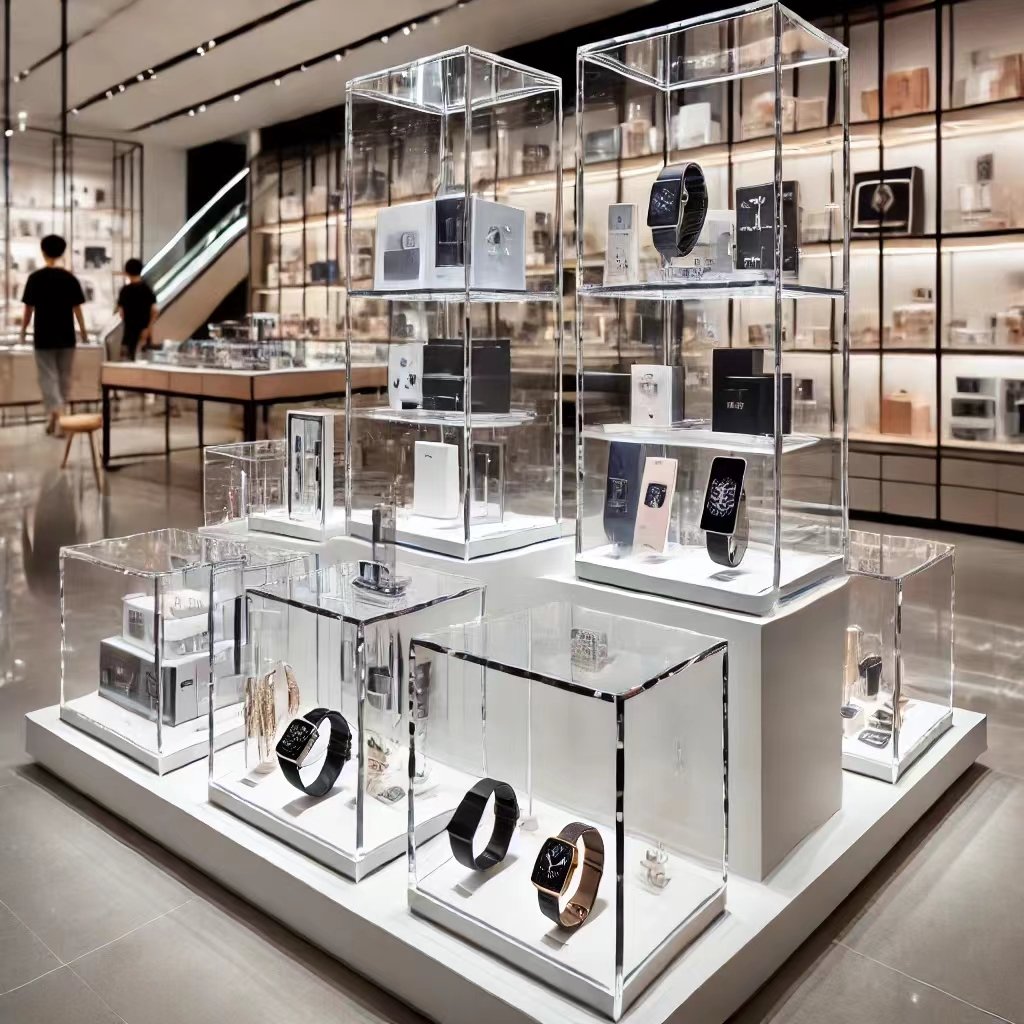

Choosing the right material for store displays plays a crucial role in how products attract customers. I always start by considering the timeless appeal of glass. Glass offers a clear and elegant appearance that instantly elevates the look of any product. At Fairwill Display, I use tempered glass because it’s durable and strong, perfect for busy retail environments. Tempered glass can withstand substantial impact, making it a reliable choice for showcasing high-end products.
However, I also recognize that different stores have different needs. Acrylic offers versatility that glass sometimes lacks. It’s lightweight, which makes it easier to move and install, especially for larger displays. Acrylic doesn’t shatter like glass, which adds a layer of safety, particularly in high-traffic areas. Moreover, acrylic’s flexibility in design allows me to mold it into various shapes and sizes, providing more creative freedom in store layouts.
Transitioning from these considerations, I weigh the specific requirements of each store when deciding between glass and acrylic. Each material has its unique strengths. For high-end boutiques aiming for luxury, I lean towards glass. For stores that need flexibility and durability without the weight, acrylic becomes the preferred option. Both materials serve their purpose effectively, and my goal is to help each store make the choice that best enhances their product display and customer experience.
2. The Versatility of Acrylic in Store Displays
Acrylic offers a level of versatility that makes it an excellent choice for store displays. When I think about why many retailers opt for acrylic, several factors come to mind. First, acrylic is lightweight, which makes it easier to handle compared to glass. I find that this quality becomes especially important when dealing with large display cases. Moving and installing these cases becomes much simpler, saving time and reducing the risk of damage during setup. In stores where displays need frequent changes, the lightweight nature of acrylic makes it a practical choice.
Moreover, acrylic’s flexibility in design offers creative possibilities that glass doesn’t. I can mold acrylic into various shapes and sizes, allowing for customized display solutions. This flexibility allows me to cater to different store layouts and product types. For instance, in a boutique setting, I might use acrylic to create uniquely shaped display cases that add a touch of modernity and sophistication. The ability to customize means I can create displays that not only showcase products effectively but also enhance the overall aesthetic of the store.
Another significant advantage of acrylic is its impact resistance. Unlike glass, acrylic doesn’t shatter when struck. This quality makes it a safer option, particularly in environments with high foot traffic or where children are present. I’ve seen this benefit firsthand in stores where safety is a top priority. Acrylic’s durability also means that it can withstand the wear and tear of a busy retail environment without losing its clarity or shape. This long-lasting nature of acrylic ensures that store displays remain attractive over time, which is essential for maintaining a high standard of presentation.
Transitioning from its physical properties, I also consider the cost-effectiveness of acrylic. Acrylic is generally less expensive than glass, both in terms of material costs and transportation. The lighter weight of acrylic reduces shipping costs, making it a more economical choice, especially for large orders. This cost efficiency becomes a significant advantage for businesses like Ariel’s, where budget considerations play a crucial role in decision-making. By choosing acrylic, I can provide a high-quality display solution that doesn’t break the bank.
However, I always keep in mind the aesthetic differences between acrylic and glass. While acrylic offers many practical benefits, the look and feel of glass often appeal more to luxury brands. Glass provides a sense of weight and clarity that acrylic doesn’t quite match. When working with high-end boutiques, I sometimes find that the luxurious appearance of glass aligns better with their brand image. In such cases, I weigh the practical advantages of acrylic against the premium feel of glass, helping clients make a choice that best reflects their store’s identity.
In conclusion, acrylic offers numerous benefits for store displays, from its lightweight and flexible design to its durability and cost-effectiveness. I consider these factors carefully when advising clients on the best material for their displays. Whether the priority is safety, budget, or aesthetics, acrylic provides a versatile and reliable option that meets a wide range of needs. By understanding the unique advantages of acrylic, I can help retailers create effective and attractive displays that enhance their overall store experience.
3. Durability: Glass vs. Acrylic
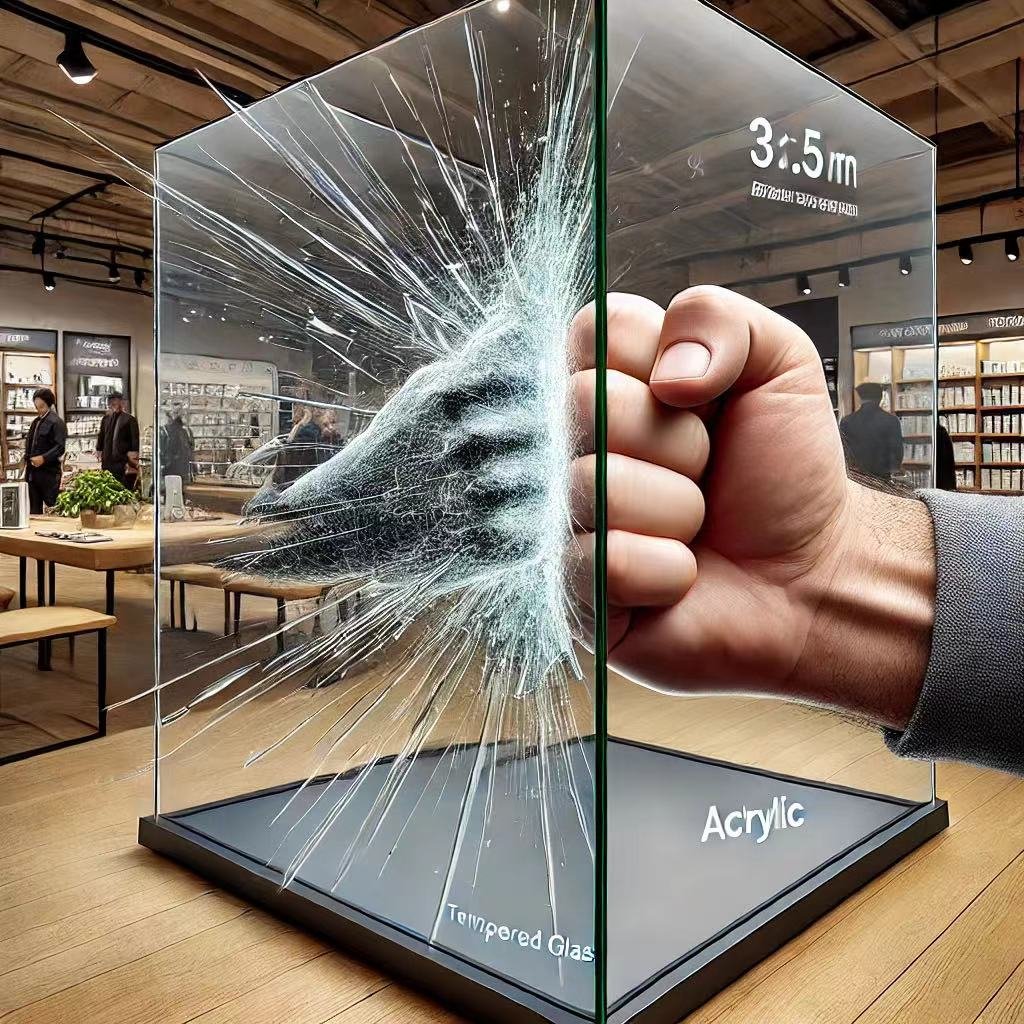
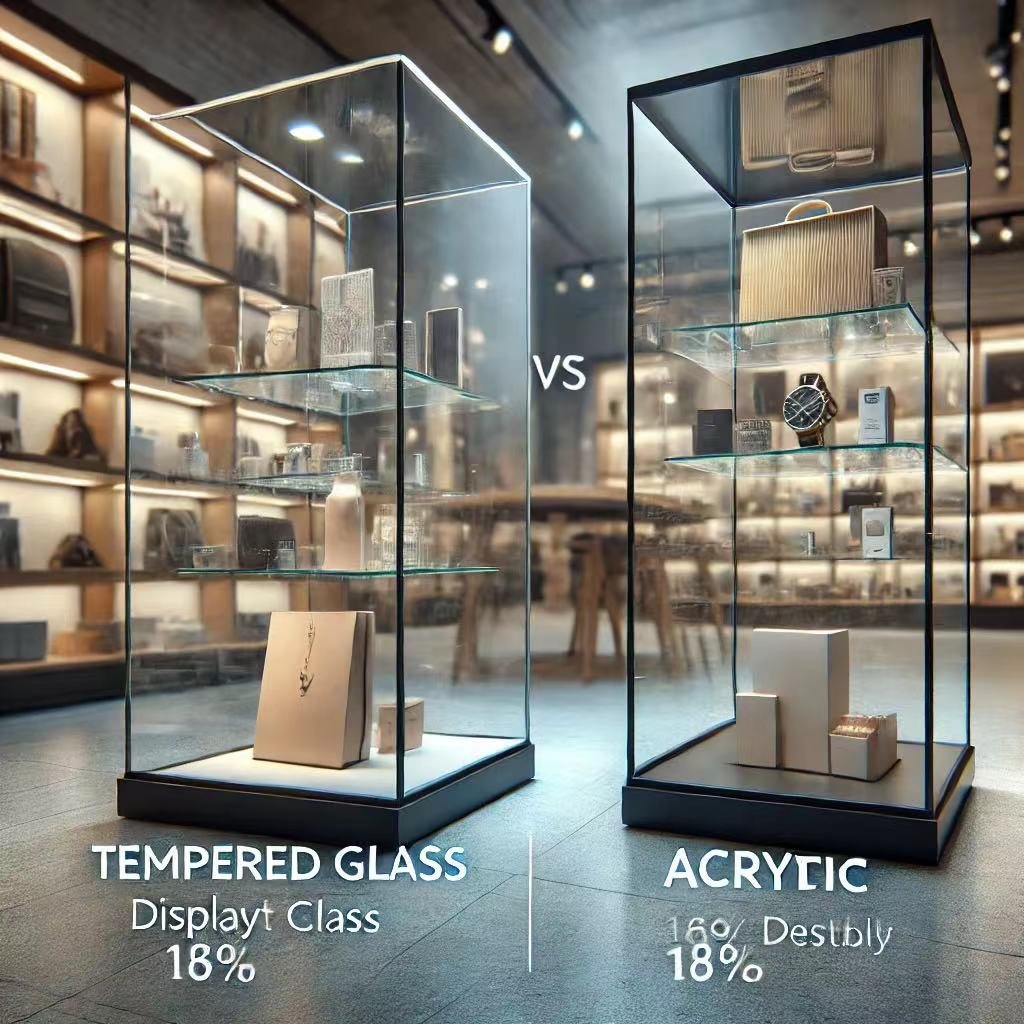
When I consider the durability of glass versus acrylic for store displays, I focus on their strengths and how they meet different needs. I start with tempered glass, known for its exceptional strength. This type of glass undergoes a heating and cooling process, which increases its resistance to impact. I find tempered glass ideal for high-traffic retail environments where displays might encounter occasional bumps or knocks. Despite its strength, if tempered glass breaks, it shatters into small, blunt pieces, reducing the risk of injury. This safety feature makes it a reliable choice for stores that prioritize both durability and safety.
On the other hand, I recognize that acrylic offers a different kind of durability. Acrylic resists impact even more effectively than tempered glass. This material does not shatter but instead can absorb impact, making it a safer option in environments with high foot traffic or where children are present. Acrylic’s flexibility also means it’s less likely to crack or chip compared to glass. However, acrylic’s susceptibility to scratching is something I always consider. While it resists breakage, it requires more careful handling to maintain its clear, pristine appearance.
In some cases, I notice that the choice between glass and acrylic depends on the display’s location and usage. For example, in areas where the display might endure more frequent contact, such as a checkout counter, I might lean towards acrylic. Its impact resistance ensures that it can handle the wear and tear without compromising the display’s integrity. Conversely, in a setting where the display needs to convey a sense of luxury and where contact is minimal, I find that glass delivers the premium feel that many high-end stores desire.
Moreover, I understand that durability extends beyond just resisting impact. I also consider how each material holds up over time. Glass, for example, remains clear and does not yellow or cloud with age. It retains its pristine look for years, making it a long-term investment for stores that want a durable and low-maintenance display. Acrylic, while strong and resistant to impact, can yellow over time, especially when exposed to UV light. This is a crucial consideration for stores with displays near windows or in brightly lit areas.
Another factor I weigh is maintenance. Glass, being non-porous, is easy to clean and resists most chemicals. I can use a variety of cleaning products without worrying about damage. Acrylic, though also easy to clean, requires more specific products to avoid scratching. I often recommend using a microfiber cloth and a cleaner specifically designed for acrylic to maintain its clarity. This additional maintenance step is something store owners need to consider when choosing between the two materials.
Ultimately, the choice between glass and acrylic for store displays depends on the specific needs and priorities of the store. If I’m looking for a material that offers a luxurious feel, long-term clarity, and resistance to aging, I opt for glass. However, if impact resistance and safety in high-traffic areas are more critical, I find acrylic to be the better option. Each material brings its own set of advantages, and my goal is to match these strengths to the needs of each retail environment.
4. Cost-Effectiveness of Glass and Acrylic
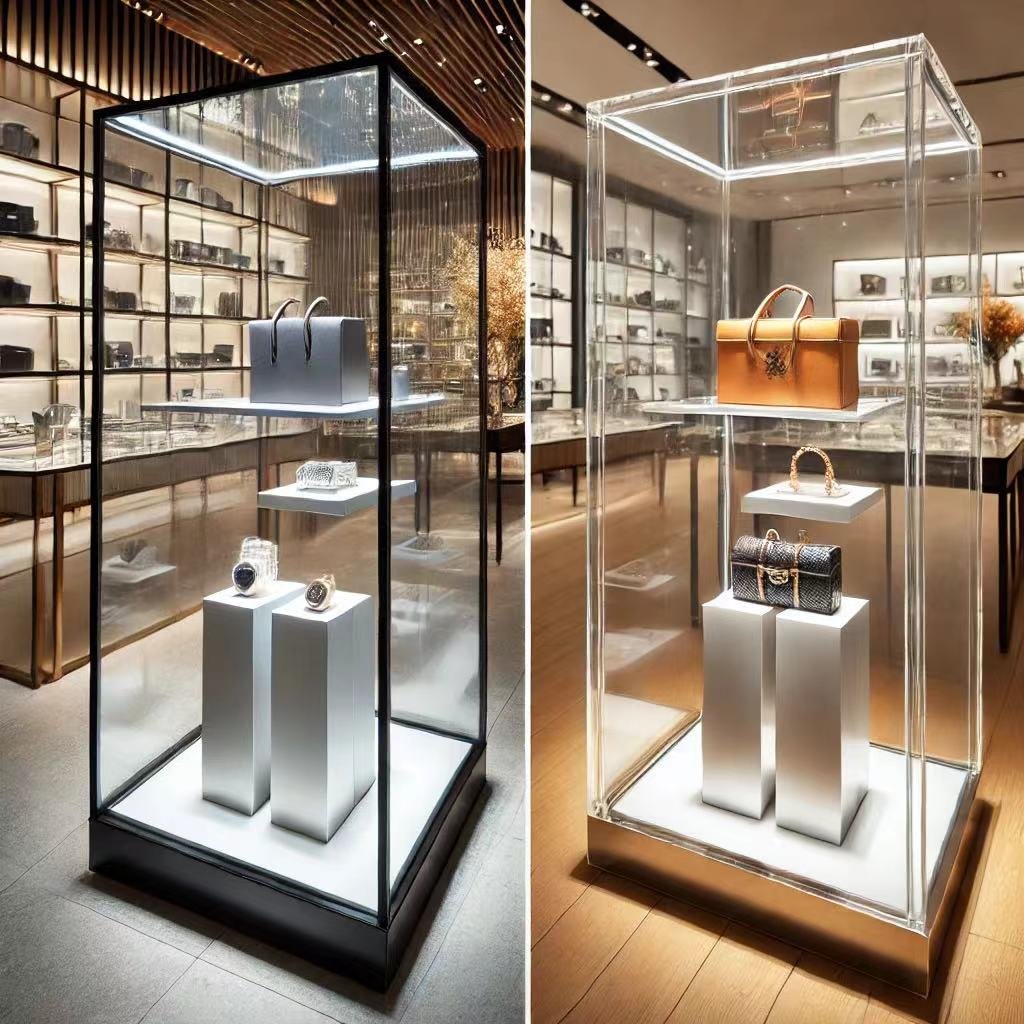
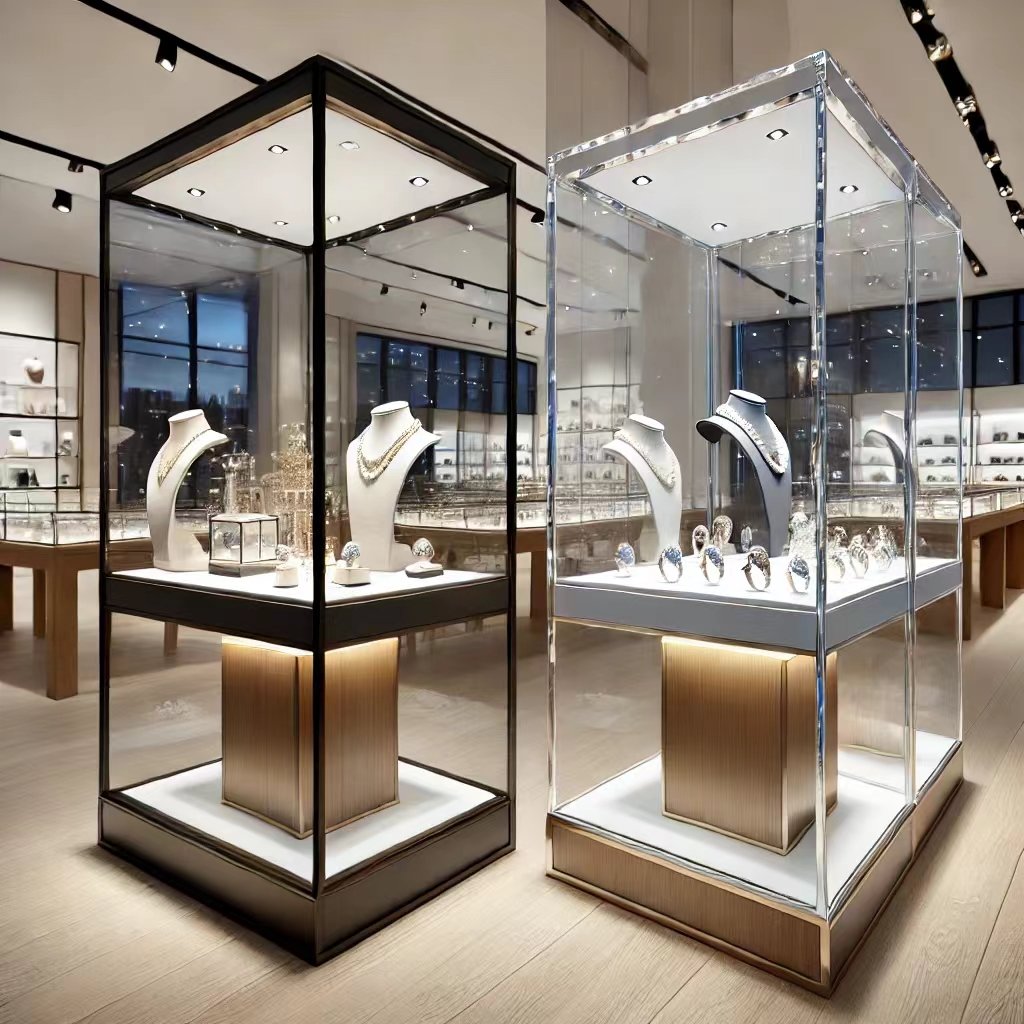
When I evaluate the cost-effectiveness of glass versus acrylic for store displays, I always start by considering the overall budget and specific needs of the store. Cost is a critical factor for any business, and understanding the financial implications of choosing one material over another can make a significant difference. Glass, particularly tempered glass, tends to be more expensive due to the processes involved in its production. This expense doesn’t just stop at the material cost; it extends to transportation and installation as well, given the weight and fragility of glass. For stores looking to create a luxurious, high-end atmosphere, the investment in glass might be justified by the premium look and feel it provides.
However, I also know that not every store has the budget to accommodate the higher costs associated with glass. This is where acrylic offers a distinct advantage. Acrylic is generally much cheaper than glass, both in terms of material cost and shipping. Its lightweight nature means it’s less expensive to transport, and it’s easier and faster to install. This can be a crucial factor for stores with tighter budgets, like those operated by price-sensitive customers. Ariel, for example, might find acrylic to be the better option, as it offers a balance between affordability and the desired aesthetic.
Transitioning from these points, I also consider the long-term costs associated with each material. Glass, while more expensive upfront, offers longevity and minimal maintenance costs. It doesn’t scratch easily, retains its clarity over time, and doesn’t yellow or degrade when exposed to sunlight. This makes glass a worthwhile investment for stores planning to use their displays over a long period. The initial higher cost of glass can be offset by its durability and the fact that it often requires less frequent replacement or repair.
On the other hand, acrylic, while cheaper initially, might incur additional costs over time due to its susceptibility to scratches and UV damage. I always advise store owners to factor in these potential costs when choosing acrylic. If the displays are located in areas with high traffic or near windows where they might be exposed to sunlight, the likelihood of having to replace or refurbish acrylic displays sooner than glass is higher. However, for temporary setups or displays that are changed frequently, the cost-effectiveness of acrylic becomes more apparent. Its lower price makes it a practical choice for stores that regularly update their displays to reflect new products or seasonal changes.
Moreover, I always emphasize that the choice between glass and acrylic should align with the store’s overall business strategy. If the store aims to position itself as a luxury brand, the higher upfront cost of glass might be justified by the premium image it conveys. Conversely, if the store’s business model is based on offering affordable products, the cost savings from using acrylic can be passed on to customers, aligning with the brand’s value proposition.
In conclusion, while both materials have their financial implications, the choice ultimately depends on the store’s specific needs, budget, and long-term strategy. Glass offers a premium, durable option that can justify its higher cost through longevity and minimal maintenance. Acrylic, meanwhile, provides a more affordable, versatile alternative that is particularly appealing for stores with tighter budgets or those that frequently change their displays. As I weigh these factors, I ensure that the choice between glass and acrylic aligns with both the immediate financial constraints and the long-term goals of the store.
5. Aesthetics: The Look and Feel of Glass vs. Acrylic
When I consider the aesthetics of glass versus acrylic for store displays, I start by focusing on the visual impact. Glass, especially tempered glass, offers a premium and luxurious feel that immediately elevates the perceived value of the products on display. I love how glass reflects light, creating a sense of elegance and sophistication in any store environment. This material provides a sense of weight and durability, which can reinforce a brand’s image as high-quality and dependable. When customers walk into a store with glass displays, they often associate the products with luxury and exclusivity, which can positively influence their purchasing decisions.
However, I also appreciate the aesthetic qualities of acrylic. While it may not have the same heft as glass, acrylic offers a clean, modern look that appeals to a different set of customers. Acrylic’s lighter nature doesn’t detract from its ability to showcase products effectively. Instead, it allows for more creative and flexible display options. I often use acrylic in stores that prioritize a contemporary, minimalist aesthetic. Acrylic can be molded into various shapes, enabling me to create unique, eye-catching displays that stand out in a competitive retail environment.
Transitioning from material properties, I also think about how these aesthetics align with brand identity. Glass suits brands that emphasize tradition, craftsmanship, and luxury. It’s a material that exudes timeless elegance. When I use glass in displays, I know it will help create a serene, high-end atmosphere that encourages customers to take their time and appreciate the finer details of the products. On the other hand, acrylic aligns well with brands that focus on innovation, affordability, and modern design. Its versatility in shape and form allows me to create dynamic displays that convey a sense of energy and forward-thinking, perfect for brands that want to appear cutting-edge.
Moreover, I must consider the practical side of aesthetics. Glass, while beautiful, requires careful handling. Its weight and fragility mean that it’s best suited for stores where the displays will remain in place for extended periods. I wouldn’t recommend glass for environments where displays need frequent rearranging. In contrast, acrylic’s lightweight nature makes it much easier to move and reconfigure. This flexibility is a significant advantage in stores that frequently update their displays to reflect new inventory or seasonal changes. I often choose acrylic when I need to create a vibrant, ever-changing retail space.
Finally, the decision between glass and acrylic often comes down to the specific goals of the store. If the store aims to create an environment of luxury and permanence, glass is the material I recommend. It’s the ideal choice for showcasing high-end, high-value items in a way that conveys quality and durability. However, if the store prioritizes flexibility, modern design, and affordability, I lean towards acrylic. Its ability to adapt to various shapes and forms, combined with its modern look, makes it the perfect choice for dynamic, innovative retail environments.
In conclusion, both glass and acrylic offer unique aesthetic advantages that can significantly enhance the visual appeal of store displays. My goal is always to align the choice of material with the store’s brand identity and practical needs, ensuring that the final display not only looks stunning but also serves its purpose effectively. Whether I choose glass or acrylic, I know that the right display can transform a store, making it more inviting and engaging for customers.
6. Maintenance Considerations for Glass and Acrylic

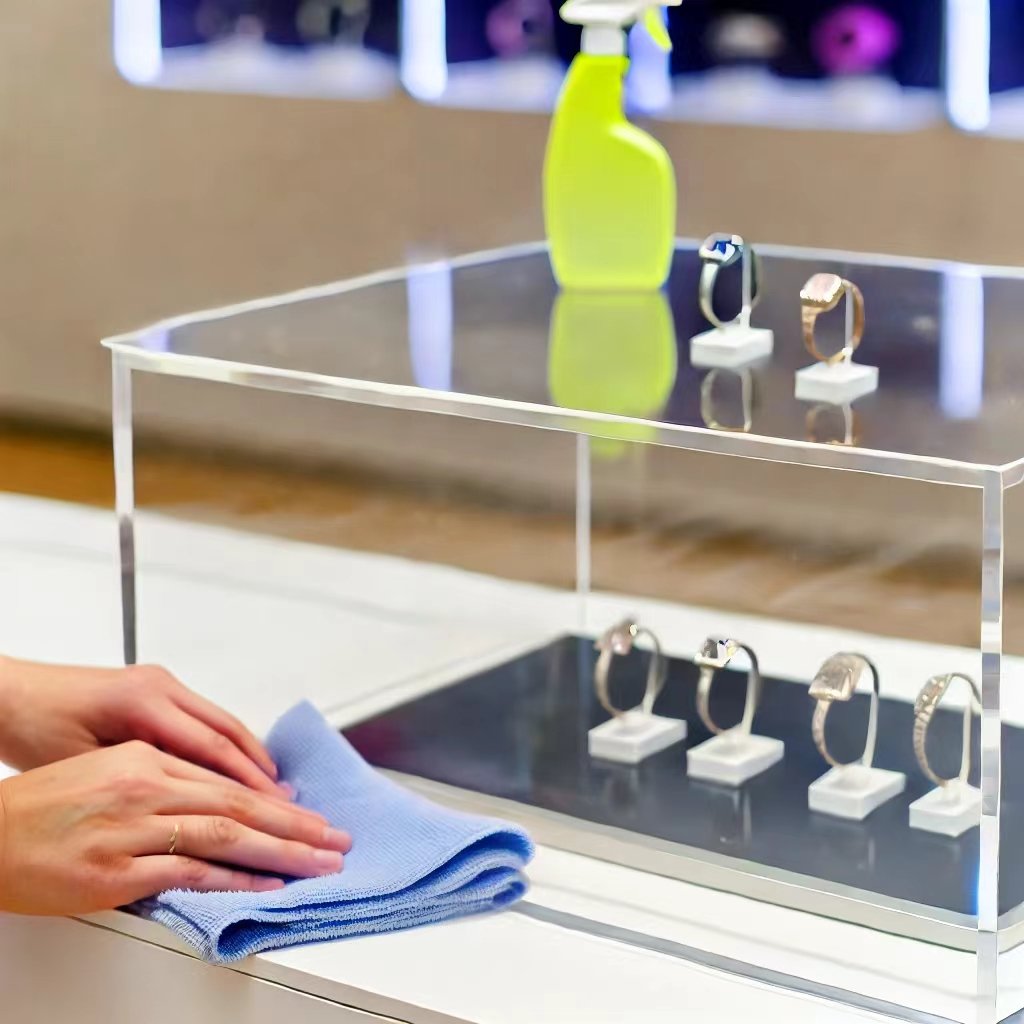
Maintaining store display cases plays a critical role in ensuring they look their best and last longer. When I consider the maintenance of glass display cases, I focus on their ease of cleaning. Glass resists most chemicals, which means I can use a wide variety of cleaning products without worrying about damage. I typically use a simple glass cleaner and a soft cloth to wipe away fingerprints, dust, and smudges. The clarity of the glass allows the products inside to shine, making the display look fresh and inviting every day.
However, I recognize that glass has its challenges. It’s heavier than other materials, which makes cleaning larger display cases more cumbersome. I always take extra care when handling glass, especially when moving or adjusting the displays, to avoid cracks or chips. Regular cleaning is essential to keep the glass looking its best, but I also make sure to inspect the edges and corners for any signs of wear. If I notice any minor damages, I address them immediately to prevent them from becoming bigger issues.
Now, when it comes to acrylic, I approach maintenance with a different strategy. Acrylic, while easier to handle due to its lightweight nature, requires more careful cleaning. I avoid using harsh chemicals or abrasive cloths because acrylic scratches more easily than glass. Instead, I opt for a gentle cleaner specifically designed for acrylic surfaces and a soft microfiber cloth. This combination helps maintain the clarity and smoothness of the acrylic, ensuring it continues to showcase the products effectively.
To minimize scratches on acrylic, I implement a few best practices. I always remove dust by gently blowing it off or using a soft brush before wiping. This prevents any particles from causing scratches during cleaning. If I do notice any small scratches, I use a plastic polish to buff them out, restoring the surface to its original condition. With these precautions, I keep acrylic display cases looking as clear and vibrant as the day they were installed.
In terms of overall maintenance, I make a habit of regularly checking both glass and acrylic cases for any issues. For glass, I focus on keeping it spotless and free of chips. For acrylic, I ensure it remains scratch-free and clear. By staying proactive in maintenance, I help extend the lifespan of these display cases, making them a worthy investment for any store. Whether I’m working with glass or acrylic, my goal is to maintain a pristine appearance that enhances the shopping experience and showcases products in the best possible light.
Ultimately, both materials require attention to detail in maintenance, but with the right approach, they can both serve their purpose effectively in any retail environment. My focus remains on ensuring that each display case, whether glass or acrylic, continues to present products beautifully and last for many years.
7. Environmental Impact of Glass and Acrylic


When I consider the environmental impact of materials, glass and acrylic present different stories. I start with glass, a material with a long history of use in various industries. Glass stands out because it’s recyclable. When I use glass, I know it can be recycled repeatedly without losing its quality or clarity. This makes glass a sustainable choice for store displays. By choosing glass, I contribute to reducing waste and conserving natural resources. Every time I recycle glass, I save energy and reduce the need for raw materials, which directly lowers the carbon footprint associated with production.
However, I also understand the benefits of acrylic in certain scenarios. Acrylic, although derived from plastic, requires less energy to produce and transport due to its lightweight nature. When I choose acrylic, I reduce the energy consumption related to shipping, especially for large quantities or long-distance deliveries. This aspect of acrylic appeals to me when considering logistics and transportation costs. I also appreciate that acrylic can last a long time if maintained properly, which means fewer replacements and less frequent production, ultimately conserving resources over time.
Moving forward, I evaluate the long-term environmental impacts. Glass, with its endless recyclability, clearly wins in terms of reducing long-term environmental harm. The recycling process for glass is straightforward and widely available, which ensures that the material stays in use rather than ending up in landfills. Acrylic, on the other hand, presents more challenges. Although it’s durable and long-lasting, it’s not as easily recycled as glass. The recycling process for acrylic is more complex and less common, which means that discarded acrylic often contributes to environmental pollution.
In conclusion, my choice between glass and acrylic depends on the specific environmental priorities of each project. If I prioritize sustainability and long-term environmental impact, I lean towards glass. Its recyclability and lower carbon footprint in production and recycling make it an environmentally friendly option. However, when logistics and transportation efficiency are critical, and when I need a material that is lightweight and versatile, acrylic becomes a viable choice. Ultimately, by carefully considering the environmental impact of each material, I make informed decisions that align with my commitment to sustainability while meeting the practical needs of the project.
8. Conclusion: Which Material Is More Suitable for Store Displays?
So, Glass or Acrylic Which Is More Suitable for Store Display? The answer depends on your specific needs. If you value a high-end, luxurious look and don’t mind the higher cost, glass is an excellent choice. It offers durability, clarity, and a premium feel that is hard to beat. However, if you need something more versatile, lightweight, and cost-effective, acrylic might be the better option. It offers many of the same benefits as glass but at a lower cost and with added safety.
In the end, both materials have their place in store displays. At Fairwill Display, we offer both glass and acrylic options to meet the diverse needs of our customers. Whether you choose glass or acrylic, you can be confident that you are getting a high-quality display case that will enhance your store’s appeal and help drive sales.
This article provides a detailed comparison between glass and acrylic for store displays, helping the reader make an informed decision based on their specific needs.
